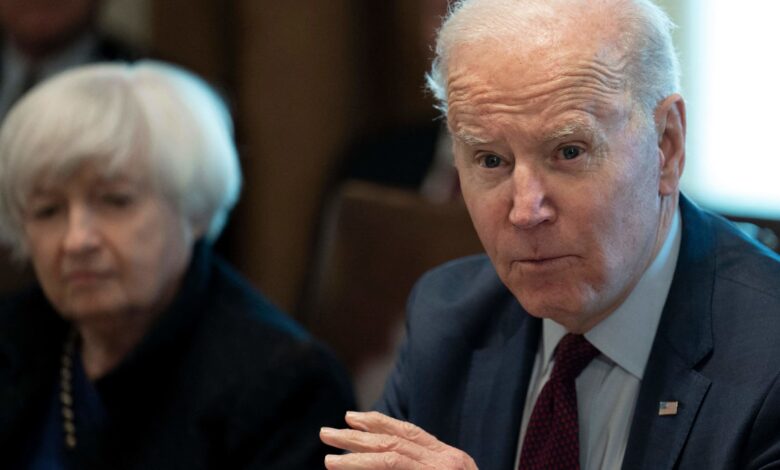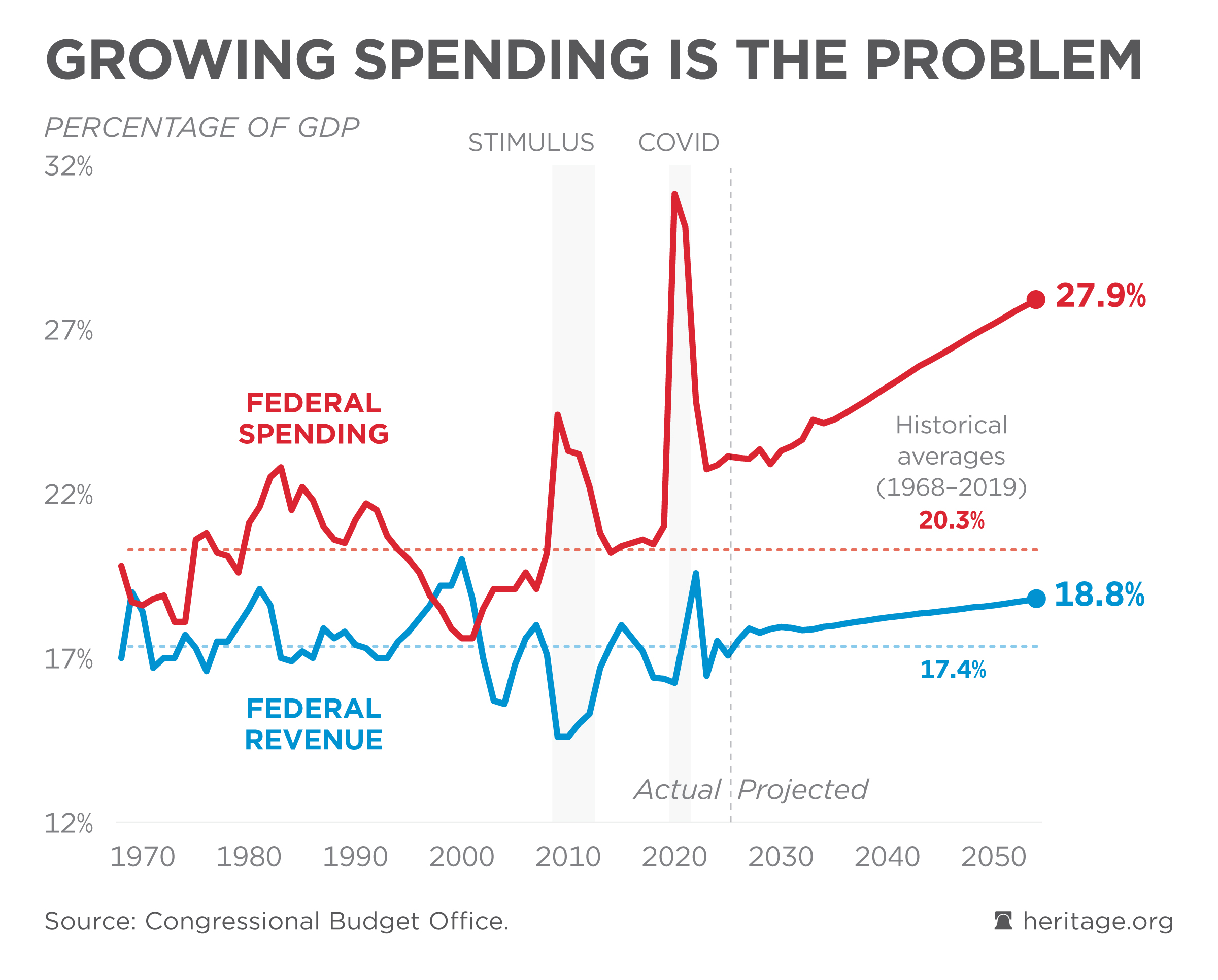U.S. Deficit Reaches $1.8 Trillion. How Long Can The U.S. Sustain Its Explosive Debt?
The United States is indeed experiencing an outsized budget deficit, fiscal year 2024 deficit landing at $1.833 trillion, the third-largest in the country's history. This is a figure that is only surpassed by the outstanding deficits experienced during the COVID-19 pandemic, which was $3.132 trillion in 2020 and $2.772 trillion in 2021. Growth in the deficit can largely be attributed to massive interest payments on federal debt, which have now crossed the $1 trillion mark for the first time, besides increased expenditure on vital services including Social Security, Medicare, and defense.

America is facing its largest financial challenge to date: a fiscal deficit of $1.83 trillion for fiscal 2024, the third-largest deficit in the history of the United States. Those deficits are greater during the COVID-19 pandemic. It is complex because there are conflicting reasons for this huge number, including a combination of factors such as continually increasing government spending, the high interest rates of federal debt, and persistent economic challenges. The deficit for the fiscal year, which ended September 30, 2024, was $1.75 trillion, representing an 8% increase over last year’s total of $1.695 trillion.
Why Does the U.S. Have a Debt Problem?
The budget deficit of the United States represents the situation where the government spends more money than it collects in revenue. In a nutshell, the government is spending much more than it is earning. This deficit is financed by borrowing funds and contributes to the federal debt. Over time, as deficits accumulate, the national debt becomes larger. The U.S. national debt for fiscal year 2024 has risen to above $33 trillion, with the annual deficit now at $1.83 trillion.
The cost of interest on the national debt is the single biggest factor driving the U.S. budget deficit in 2024. Interest payments on federal debt for the first time in history topped $1 trillion, jumping by a staggering 29% from the previous year. This rise comes from the influence of high interest rates determined by the Federal Reserve and the increase in the amount of the debt to be covered. The higher interest rate means more to pay to borrow money, whereby this directly translates to the budget deficit.
Another significant motivator is the rise in the cost of entitlement programs, with Social Security as one of them. In 2024, spending on Social Security was $1.52 trillion, up 7% from the previous year. It is caused mainly by the ageing population. The moment more people retire and claim social security benefits, the costs for the program increase significantly.
The U.S. government also spends very much on health programs like Medicare and Medicaid. In terms of health, spending in fiscal 2024 increased by 4%, with spending standing at $1.05 trillion. Healthcare costs have been rising for many years due to various factors: an ageing population, high healthcare prices, and greater demand for medical services.
Defense is one of the sectors that the United States spends a good chunk of the budget on. In 2024, the increase in defense spending was pegged at 6% to $826 billion. Maintaining such big forces is expensive-considering the present global tensions and commitments toward military operations.
Even though COVID-19 is no longer a direct cause of the deficit, the long-term implications are keeping the economy concerned. As for the direct impact on business and individuals, the U.S. government spent astronomical sums to reduce its adverse effects on the economy. The widened deficit due to this situation arises despite the gradual easing of spending from the pandemic; the added interest on the debt piled up during that time does not stop increasing.
Past Debt Problems and Solutions

The U.S. government has also incurred, at times, periodically large debt levels with budget deficits. The federal debt increased grievously during World War II, during the 1980s, and recently during the financial meltdown of 2008 and the COVID-19 pandemic. Let’s take a closer look at the efforts of past governments when these issues appeared.
After the close of the Second World War, the nation of the United States ended up burdened with a heavy national debt from war appropriations. However, the post-World War II boom in the economy helped the country grow out of its debt. Economic growth experienced during the 1950s and 1960s allowed the government to cut down on deficits and even run a surplus in the books; in other words, the debt burden started to become smaller compared with the economy.
The U.S. national debt yet again rose considerably during the 1980s, largely because of tax cuts and increased defence spending under President Ronald Reagan. The government managed to get some relief over the rising deficit by trying to increase taxes and reduce spending, though it wasn’t enough to see a steady decline of the deficit. The debt continued to rise, and further financial issues were faced in the following decade, the 1990s.
The U.S. government reduced its deficit and enjoyed a surplus in the late 1990s under President Bill Clinton. It was due to tax hikes, spending cuts, and good economic growth. However, the surplus did not last long due to tax cuts and increased military spending after the attacks on 9/11 in 2001 sent deficits again through the roof.
The 2008 financial crisis has been yet another major cause of a huge increase in the federal deficit, as the government spent lavishly to stabilize the economy and prevent a total collapse of the financial system. Just a few of the contributors to such an increasing deficit were bailouts of banks, stimulus programs, and increased unemployment benefits. A number of successes, like tax increases for high-income individuals and spending cuts in various sectors, helped curb the deficit after the crisis.
The biggest and latest increase in the federal deficit is due to the COVID-19 pandemic. During the pandemic crisis, the U.S. government had to pass multiple stimulus packages that were directed at the people, the economy, and medical providers who could provide treatment.
Those measures, however, are urgently needed to avert economic catastrophe and put trillions of dollars into the national debt. The government has not been able to do anything to decrease the deficit because interest payments and entitlement programs have been pushing it up constantly since the end of the pandemic.
Why Haven’t the Debt Problem Been Solved?

Repeated attempts made by different administrations continue to fail to solve the debt problem of the U.S.
Another leading cause of chronic debt is the existence of political gridlock. In most cases, it is impossible for the different political parties to reach agreement on how to reduce the debt. For example, some politicians claim that increasing taxes will collect more money for the government, while at the same time other politicians argue for cutting spending. The inability to agree on this usually leads to either side doing nothing about it.
The tough choices necessary to reduce the deficit often include cuts in entitlements and even popular programs like Social Security, Medicare, or defense. All these programs are highly politically charged, so any decision to cut them poses a threat to too many Americans. As a result, politicians, especially during an election year, are usually reluctant to make the tough choices needed to reduce the deficit.
As mentioned earlier, the payment of interest on federal debt becomes a growing component of the budget. The higher the national debt, the higher the interest that the government pays yearly. This thus develops a vicious cycle where increased borrowing is associated with increased interest paid and yet requires more borrowing to balance the deficit. Such a cycle only easily permits total debt reduction through paradigm shifts in government spending or revenue collection.
World economic pressures such as inflation, supply chain disruption, and political tensions make it less probable to reduce the deficit. Economic slowdowns can reduce government revenue and increase demand for government spending on unemployment benefits, among other social programs.
Effects of U.S. Debt on the Economy
The deepening U.S. debt has several ripple effects on the domestic economy, as well as the world at large.
As the government also borrows more money, the demand for credit in the financial markets increases, which can then result in higher interest rates for the government besides consumers and businesses. High interest rates make borrowing expensive for the individual with mortgages and car loans, thus lowering the rate of economic growth.
Huge deficits can also inflate the rate of inflation. Borrowing to finance its spending increases the aggregate demand in the economy. Without a balanced increase in the supply of goods and services, it can increase the rate of inflation where prices for goods and services are rising.
When the government borrows huge amounts of money, it crowds out private investment because there are more market participants competing for funds in financial markets; therefore, it becomes a challenging task for businesses to acquire loans in order to expand business, research, or increase development, slowing economic growth and innovations.
High debts, in turn, lead to a low long-term growth rate of the economy. This is likely due to the fact that when the government spends a large fraction of its budget on interest payments, it has too little with which to invest in infrastructure, education, and so on. Long-run economic progress becomes slower, and living standards will be lower than otherwise for future generations.
It is the global primary reserve currency and, therefore, used in international transactions; besides, other central banks hold it as well. However, increasing worries about the U.S. debt is likely to present a serious menace to the confidence level of the dollar, thus weakening its value as well as increasing the import prices of America. A weaker dollar will also mean higher inflation, as imported goods cost more.
Impact on the Global Economy

The economy of the United States is the world’s largest, and whether it is in a healthy state or not has had a cascading consequence for the global economy.
High debt levels in the U.S. bring uncertainty to the global financial markets. It will be a cause for concern for investors about the sustainability of U.S. government finances. It will raise volatility in the stock and bond market, which has a ripple effect in economies throughout the world, especially those that heavily rely on trade with the United States.
Many emerging markets are dependent on U.S. investments and trade. The rise of U.S. interest rates, because of the added pressure to fund higher debt, eventually leads to the arising of capital outflows from different emerging markets. These may subsequently have a negative influence on the respective countries’ currencies and financial systems. This can further contribute to slower growth while raising the vulnerability of those countries to financial crises.
The U.S. debt situation will also touch on the nation’s relationships with other countries on trade. As the dollar depreciates, it is likely to lead to a form of trade imbalance because imports become pricier and exports become cheaper. This may result in tension from other countries because their economies will be affected.
High levels of debt in the U.S. may limit the country’s potential to maintain its influence in the rest of the world. Poor economic conditions resulting from unsustainable levels of debt would impact the U.S.’s leadership role in organizations around the world and reduce its capability to respond to global challenges.
Possible Options to End the Debt Problem
The U.S. has stiff challenges because it grapples with budget deficit and national debt. Still, however, there are a number of possible options that the policymakers can consider.
Some sources of revenue increase can be tax reform. This can be achieved by raising the tax on high-income individuals, closing loopholes that help the wealthy and corporations, and making sure big corporations pay their fair share of taxes. Revenues to government coffers may increase this way, possibly without cutting necessary programs in order to reduce the deficit.
For instance, it would limit the government expenditure of its non-essential branches, thereby reducing the deficit. Such would include cuts in discretionary spending either through tangible government programs or reform of entitlement programs to ensure that they are sustainable in the long run. However, any cut in government spending should be done cautiously so that the weak and vulnerable people do not get hurt in the process.
Another key component of reducing the deficit is encouraging economic growth. Investments in infrastructure, education, and research and development represent a means by which the government can encourage economic activity and increase tax revenue. An expanding economy can balance budget deficits and eventually begin lowering the debt-to-GDP ratio.
Another significant aspect is debt management. Debt management can be in the form of debt refinancing, especially high-interest debt, to lower rates. It can even extend the maturity date of government bonds or employ fiscal tools for interest payments rising on such government bonds. Proactive management of debt reduces the budget burden from interest payments.
It is the bipartisan cooperation that would solve the debt issue. There has to be consensus on how the deficit will be cured in order to agree on a sustainable budget policy. Bipartisanship is expected to trigger policies that can maintain social programs while generating revenues.
The United States also faces a budget deficit of $1.83 trillion in the fiscal year of 2024, primarily due to the high and rising interest payments on debt, increased spending on social security and healthcare programs, and never-ending costs of defence.
The historical context of the past debt crisis shows evidence that, even in their darkest financial years, solutions did exist for the U.S. Unfortunately, this may require ultimate political will, effective changes in policy, and fiscal responsibility to stop the ever-growing deficit and its implications on the U.S. economy and the global economy at large. It will be a never ending cycle of debt with all its potential consequences, reaching generations and beyond, if no action is taken.




